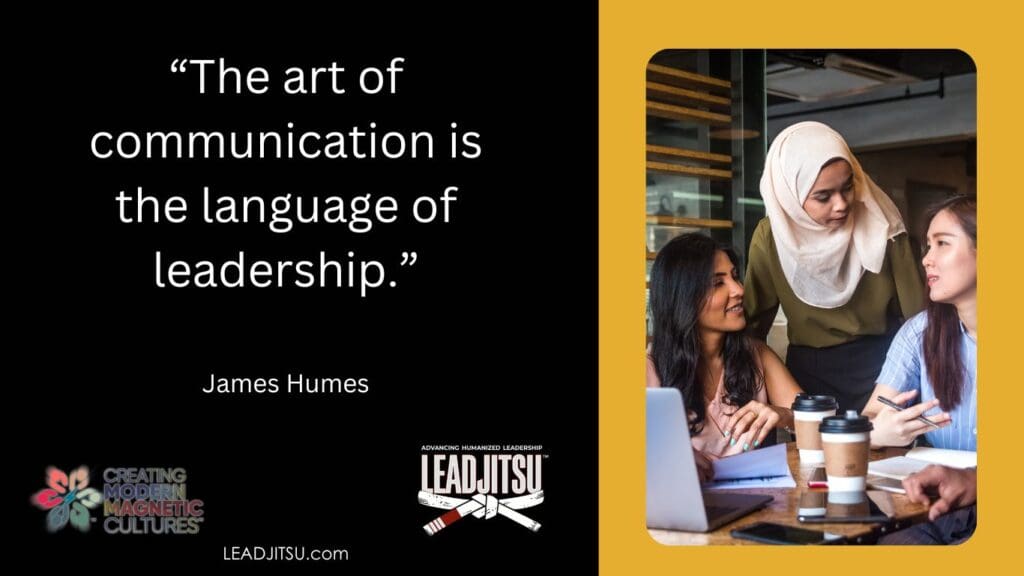James Humes wisely said, “The art of communication is the language of leadership.” In the world of effective leadership, communication is not just a tool; it’s the foundation of trust, connection, and success. When leaders master communication, they don’t just share information—they inspire action, build strong relationships, and drive performance. Without strong leadership communication, even the best strategies will struggle to succeed.
For leaders looking to improve leadership communication, the LEADJITSU Leader’s Code offers a comprehensive framework for mastering this essential skill. In this post, we’ll explore how the principles of LEADJITSU can help leaders communicate effectively, bridging gaps and enhancing team collaboration.
Why Leadership Communication is Important
Strong leadership communication is critical for a variety of reasons:
- Boosts Team Morale: Clear and consistent communication from leaders helps teams feel informed, valued, and aligned with organizational goals.
- Enhances Trust: When leaders communicate openly and honestly, it builds trust within the team, reducing misunderstandings and improving workplace relationships.
- Inspires Action: Great leadership communication motivates teams to perform at their best, ensuring that directives are understood and acted upon with confidence.
- Facilitates Problem-Solving: Open communication allows teams to address issues head-on, paving the way for faster, more effective solutions.

3 Ways to Improve Leadership Communication Using LEADJITSU Principles
To improve leadership communication, we can look to the LEADJITSU Leader’s Code for guidance. Here are three key strategies leaders can use to enhance their communication skills and foster a more connected, engaged team:
1. Bridge Communication: Connecting Understanding with Action
One of the most important aspects of leadership communication is ensuring that messages are clear and understood by all. In LEADJITSU, Bridge Communication emphasizes the power of connecting communication with action. Like a martial artist who bridges mental and physical discipline, leaders must ensure their words lead to meaningful action.
Strategy to Improve Leadership Communication: Focus on clarity and active listening. When giving instructions or sharing updates, make sure your message is simple and easy to understand. Check for understanding by asking your team to repeat key points or share their thoughts on the discussion. In team meetings, practice active listening by being fully present and engaged, showing through your body language and responses that you value your team’s input.
2. Sensei’s Humility: Fostering a Feedback Culture
Great leaders know that communication is a two-way street. In LEADJITSU, Sensei’s Humility teaches the importance of continuous learning and growth. This principle encourages leaders to embrace feedback—both giving it constructively and receiving it with an open mind.
Strategy to Improve Leadership Communication: Build a feedback-friendly culture where open dialogue is encouraged. Make time for regular check-ins with your team to discuss what’s working and what could be improved. Invite feedback on your leadership style and communication practices. Show your team that you’re committed to growing alongside them by acting on the feedback you receive. This openness will strengthen your leadership communication and foster trust within your team.
LEADJITSU Ignite Leadership Team Intensive
In the pursuit of humanized leadership, it’s not just about leading individually—it’s about creating a unified, thriving team. The LEADJITSU Ignite Leadership Team Intensive is a transformative six-month journey designed to harmonize your leadership team around core principles of respect, inclusivity, and communication. This program fosters a culture where leaders and their teams grow together, embracing a shared vision and driving sustainable success.
Empower your team to lead with heart, purpose, and unity. Let’s ignite this journey together. Schedule a complimentary consultation.
3. Warrior’s Courage: Communicating with Conviction
Difficult conversations are an inevitable part of leadership, but avoiding them can create bigger problems down the line. Warrior’s Courage in LEADJITSU teaches leaders to confront challenges head-on, including tough conversations. Leaders must have the courage to be direct, transparent, and honest, even when the message is difficult.
Strategy to Improve Leadership Communication: Be clear and empathetic when addressing tough topics. Whether it’s delivering constructive feedback or sharing a challenging update, approach the conversation with courage and empathy. Use direct language but remain compassionate, acknowledging the emotional impact on your team. By practicing courageous communication, leaders can address issues before they escalate, and teams will appreciate your willingness to tackle challenges openly.
How to Improve Leadership Communication with LEADJITSU
Improving leadership communication requires intention, practice, and a commitment to growth. Leaders who actively work on their communication skills will see a marked improvement in team collaboration, morale, and productivity. By applying the LEADJITSU Leader’s Code—through Bridge Communication, Sensei’s Humility, and Warrior’s Courage—leaders can create an environment of trust, openness, and mutual respect.
Conclusion: The Importance of Leadership Communication
Strong leadership communication isn’t just a skill—it’s a necessity for driving team success. Leaders who communicate clearly and consistently are better able to inspire, motivate, and guide their teams toward shared goals. By improving leadership communication with the LEADJITSU Leader’s Code, leaders can ensure that their words don’t just inform, but inspire action, build trust, and lead to meaningful change.
If you’re looking to enhance your leadership communication, start by practicing these principles. The art of communication is, indeed, the language of leadership—when mastered, it’s the key to unlocking your team’s full potential.



